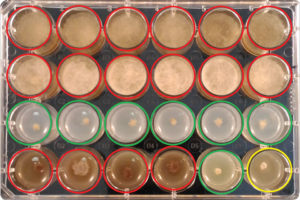Fungicide Resistance in Botrytis is an International Challenge

To test for fungicide resistance, six spores are collected from infected plants (each column represents a spore from the same diseased sample) and placed onto Petri dishes containing a fungicide (each row is a different fungicide). If the fungus is resistant to the fungicide, the spore will germinate and grow as identified by the yellow and red circles. Sensitive spores do not grow as identified by the green circles.
Control of Botrytis cinerea is one of the biggest challenges facing the cut rose industry. Symptoms appear on the petals, as well as on the stem at the base of the flower. Although growers implement cultural methods to reduce disease, they are still dependent on fungicide application. However, many of our safest fungicides are vulnerable to resistance development, and this has become a serious issue for the industry.
Path for Exploring Botrytis of Cut Roses
Dr. Guido Schnabel’s team at Clemson University has been assessing Botrytis management strategies in fruit cropping systems for several years. Their research has demonstrated that fungal isolates collected from commercial strawberry and blackberry fields were resistant to many fungicides belonging to different chemical classes, including those categorized by the EPA as reduced risk. Armed with years of experience, the team started working with Dr. James Faust on the same pathogen affecting ornamental crops. When preliminary results indicated there was also a problem with Botrytis in samples from commercially grown petunias, the American Floral Endowment decided to support further exploration of Botrytis on cut roses.
Plan of Action for Determining Fungicide Resistance
Our team conducted two studies to determine the extent of fungicide resistance in the rose industry. In the first study, Botrytis samples were collected from cut roses from five countries, including Colombia, Equador, Guatemala, Kenya, and Mexico. In the second study, Botrytis samples were collected from cut roses from the same Colombian greenhouse over several months.
For both studies, the imported roses were placed in humidity chambers to promote Botrytis spore production. Spores were then collected and placed in growing medium containing fungicides from seven chemical classes or FRAC (Fungicide Resistance Action Committee) codes. After a few days, the spores would only germinate and develop a fungal colony if the isolate was resistant to the fungicide.

Figure 1. Botrytis symptoms typically appear on petals or at the base of the head.
It’s a Small World After All
The Botrytis samples collected from all five countries were resistant to one or more FRAC codes. Not much to our surprise, the isolates collected from four of the five countries exhibited a very high level of resistance to thiophanate-methyl (FRAC 1). This is one of the oldest fungicides with a single mode-of-action registered. Sensitivity to cyprodinil (FRAC 9) was also reduced in most samples. Other fungicides, such as iprodione (FRAC 2), boscalid (FRAC 7), fludioxonil (FRAC 12), and fenhexamid (FRAC 17), expressed a variable response depending on greenhouse location. Very little resistance to polyoxin-D was detected.
In the second study, Botrytis samples were collected from the same plants in the same greenhouse over a period of six months. The results showed resistance to thiophanate-methyl, iprodione, and cyprodinil persisted over the experimental period, while resistance to boscalid, fludioxonil, and fenhexamid varied from week to week. No Botrytis samples collected over the course of the shipments showed resistance to polyoxin-D.
Take-Home Message
Botrytis is a fungus with an incredible ability to adapt to environmental stresses, including fungicides. The high selection pressure exerted from frequent fungicide applications in greenhouses has resulted in resistance development in Botrytis across cut-rose-producing countries on multiple continents. As a result, some fungicide applications may not be effective and fungal spores could build up unintentionally and cause later problems, not to mention the waste of resources connected with applying an ineffective product.
Growers must employ resistance management strategies to prevent this situation and to improve the longevity of the fungicides that are currently available. Botrytis is at the highest risk of infection when plant tissues are wet or are in a very humid environment (>94% relative humidity) for more than 12 hours and temperatures are 60°F to 75°F. Adjusting the environment is the best means of preventing Botrytis infection, but this is not always possible.
Rotation of chemical classes or FRAC codes is important, but rotation of chemical classes must be more strategic than a simple run through the fungicide list. For example, single-mode-of-action fungicides should be applied infrequently to minimize selection for resistance. This could be accomplished by using less effective materials that do not select for resistance during periods of low risk of infection. Finally, proper sanitation and removal of debris from the greenhouse should never be forgotten as an extremely helpful technique for minimizing the spore population, and thus the disease pressure.
Melissa Muñoz is a graduate student, and Drs. Guido Schnabel and James Faust are faculty at Clemson University in Clemson, SC. The authors thank the American Floral Endowment for its financial support of this project and Floralife for coordinating the shipments and supplying the flowers.










